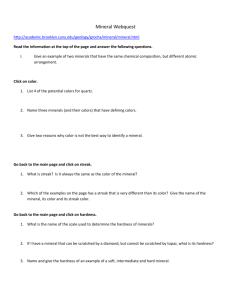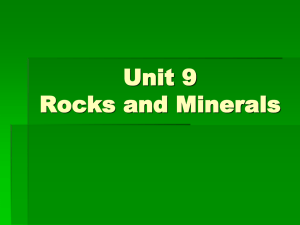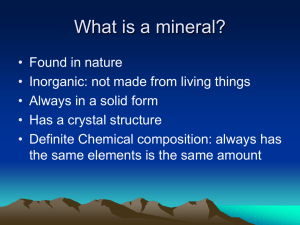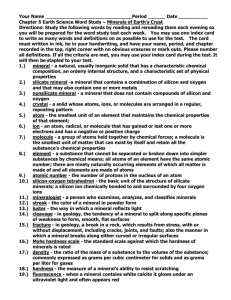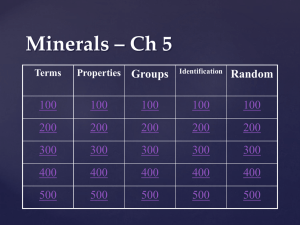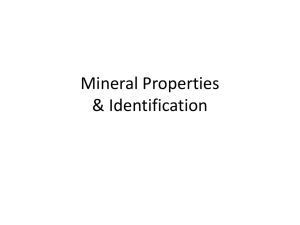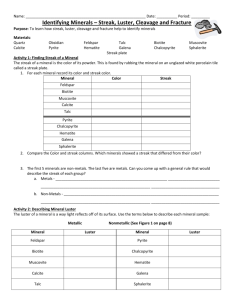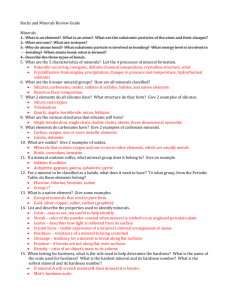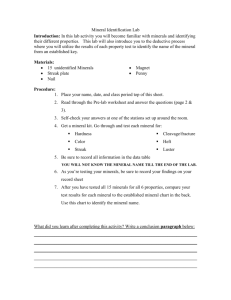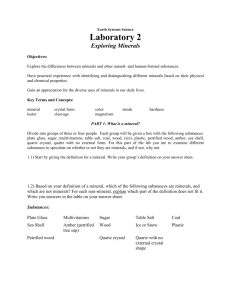Mineral Webquest http://academic.brooklyn.cuny.edu/geology
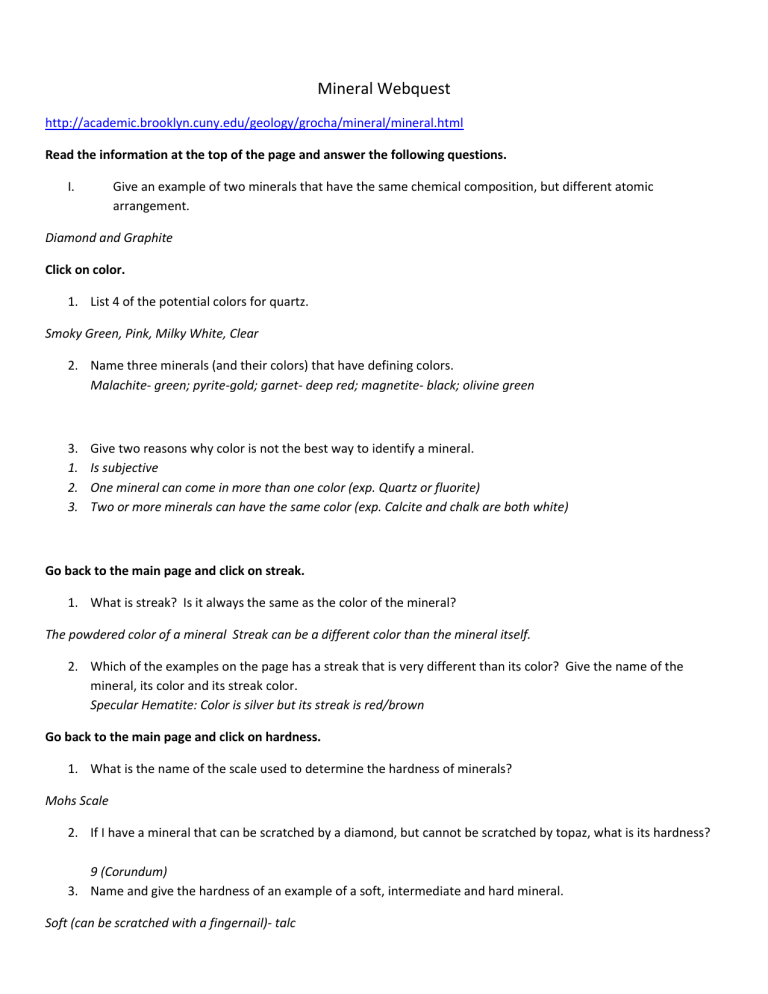
Mineral Webquest
http://academic.brooklyn.cuny.edu/geology/grocha/mineral/mineral.html
Read the information at the top of the page and answer the following questions.
I.
Give an example of two minerals that have the same chemical composition, but different atomic arrangement.
Diamond and Graphite
Click on color.
1.
List 4 of the potential colors for quartz.
Smoky Green, Pink, Milky White, Clear
2.
Name three minerals (and their colors) that have defining colors.
Malachite- green; pyrite-gold; garnet- deep red; magnetite- black; olivine green
3.
Give two reasons why color is not the best way to identify a mineral.
1.
Is subjective
2.
One mineral can come in more than one color (exp. Quartz or fluorite)
3.
Two or more minerals can have the same color (exp. Calcite and chalk are both white)
Go back to the main page and click on streak.
1.
What is streak? Is it always the same as the color of the mineral?
The powdered color of a mineral Streak can be a different color than the mineral itself.
2.
Which of the examples on the page has a streak that is very different than its color? Give the name of the mineral, its color and its streak color.
Specular Hematite: Color is silver but its streak is red/brown
Go back to the main page and click on hardness.
1.
What is the name of the scale used to determine the hardness of minerals?
Mohs Scale
2.
If I have a mineral that can be scratched by a diamond, but cannot be scratched by topaz, what is its hardness?
9 (Corundum)
3.
Name and give the hardness of an example of a soft, intermediate and hard mineral.
Soft (can be scratched with a fingernail)- talc
Intermediate (Cannot be scratched with a nail but can be scratched with a steel nail)- calcite
Hard (Cannot be scratched with a steel nail)- quartz, topaz, corundum, diamond
Go back to the main page and click on cleavage/fracture.
1.
What is cleavage? What is fracture?
Cleavage- tendency of a mineral to break along smooth, flat surfaces
Fracture- tendency to break on a curved or jagged surface
2.
Complete the following chart.
Mineral Type of Breakage
Halite Cleavage
Calcite
Gypsum
Muscovite
Feldspar
Quartz
Cleavage
Cleavage
Cleavage
Cleavage
Fracture
3.
Which of the two minerals above have cleavage in one direction?
Gypsum and muscovite
Go back to the main page and click on Reaction to HCl
1.
What class of minerals generally fizz when they come in contact with HCl?
Carbonates
2.
Is it possible to distinguish chalk from kaolin without using acid? Explain.
No. They are the same in all other physical properties, except for their reaction to acid.
3.
Can you distinguish white calcite from white feldspar without using acid? Explain.
Yes, they have different hardness values.
Go back and click on Magnetism.
1.
What is the most common magnetic mineral?
Magnetite
Mineral Identification http://www.mineralogy4kids.org/minid/id.html
Click on start mineral identification. Answer the questions given to you on the screen about the first mineral on the chart below. Choose from the minerals listed in step 5 to determine the name of your mineral.
Click back to step 1 for each of the remaining 3 minerals on your chart.
Use the information found on this chart below and the website above to correctly identify each mystery mineral.
Mineral
Number
1
Luster Color
White
Streak
White
Hardness
1
2
3
4
Nonmetallic
Metallic
Nonmetallic
Metallic
Yellow/brown Yellow
Dark green to black
Brass yellow
Pale green
Green black to brown black streak
3.5
5-6
6-6.5
Cleavage/Fracture Additional
Information
Basal cleavage Feels greasy and is flaky
6 directions cleavage
2 directions of cleavage at close to 90 o
No cleavage
Rotten egg smell
Is a silicate
Composed of sulfur and iron
Identity of Mystery Minerals
#1 __Talc______________________
#2 ___Sphalerite_____________________
#3____Augite____________________
#4 ______Pyrite__________________
Scrambled Mineral Words http://www.quia.com/jw/8088.html
Go to the following website and unscramble the terms related to minerals.
Write your answers below. Define 5 of the terms in the space to the right. Answers will vary
1.
2.
3.
4.
5.
6.
7.
8.
9.
10.
11.
12.
13.
14.
15.
16.
